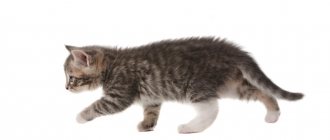Dear cat owners! I have a problem. I ask for advice and help from those who have encountered a problem like mine. The point is this.
Last year they gave us a little cat. It was a beautiful snow-white miracle with different eyes - one green, the other bright blue. She was about 2 months old. Now it’s 10 months, maybe a little less. Now she is a magnificent snow-white queen with thick long hair and a bushy tail. Of course, she is a little deaf (her ear cannot hear on the side of her blue eye), but this does not prevent us from loving and caring for her.
But then our beautiful Snowy developed a strange mania: she began to eat cardboard. While there is no shortage of food, there is also no shortage of vitamins. We grow grass for her (we sow oats). But she prefers to sleep in the grass, and eats very little of it. And here it is, eating cardboard.
Ten days ago, at night, I chewed up the box in which my granddaughter’s new sandals lay. The matter ended with surgery. It turned out okay, although according to the veterinarian, the case was serious. Tomorrow they will remove the stitches from my tummy.
Has anyone had the same problem and how to stop a cat from chewing cardboard? Help with advice! I will be very grateful. After all, after the operation, she tasted a cell phone box. It’s good that we saw it and took it away on time. I really hope for your experience.
It would seem that we already know everything about domesticated cats. But sometimes their behavior becomes a real discovery for a person. For example, they may start playing with things that are completely inappropriate for this. Such things include cardboard boxes, which they chew and use as shelter, as well as plastic bags.
Warm
It is unlikely that a cat can freeze in a city apartment, unless it is a hairless breed (Sphynx, Rex). But according to cats, there is no such thing as too much heat. They can bask in the sun's rays and hug the battery for hours. Sometimes a cat's fur gets so hot from the radiator that it scares its owners. But the pet feels blissful, as if the warmth allows him to recharge his internal batteries.
A cardboard box is a great way to accumulate heat inside and keep warm. Corrugated cardboard is a good thermal insulator. And for lack of anything better, any container of a suitable size prevents body heat from evaporating, warming the fluffy frog.
Experimenting with boxes and bags - is this normal?
Whiskered pets are true explorers. They are interested in everything - from your slipper to devices that are incomprehensible to them, for example, household appliances that make questionable sounds. Cats can be attracted to even such seemingly ordinary things as a cardboard box or a standard plastic bag with which you go to the store.
What do people do when they see their beloved pet not wanting to get out of the box or furiously tearing the bag? It is clear that they begin to think about the worst. For example, that the animal is sick. You might think that he has stomach problems or that his body lacks some substances. Some particularly impressionable owners begin to panic, believing that the cause of this behavior is rabies.
Cats easily use boxes for shelter and manage to chew them
In fact, not a single cat is immune from diseases, including serious ones. But in this case, it is unlikely that they will be interested in boxes with packages. An animal with rabies will choose to attack living creatures, including the owner
So everything is much simpler here and, importantly, safer
Who are cats? That's right, these are predators. Despite the fact that these are domesticated animals, instincts still do not disappear anywhere, they just sleep. That is why the cat always strives to occupy a secluded, secluded place. And the box or package, in her opinion, is exactly what is needed.
And if a cat chews these things, it means that he is simply training his jaws and teeth. Again - because he is a predator. If he does not do this, he will lose his hunting abilities, and this is already very bad for the animal.
Cats love music too
These animals have a very developed sound, in the sense that they can pick up very high frequencies, unlike humans. Therefore, cats perceive surrounding sounds a little differently than we do. In other words, we can say that they have a truly musical ear.
When a pet hears unusual acoustic signals, it becomes interested in them. Cardboard and polyethylene may well be sources of such sounds. They will also intensify if they are inside a bag or box at this time. After all, cats mostly chew such things when they sit inside them, and not outside - here is your answer why this is so.
In general, there is nothing so seditious about the fact that your cat chews cardboard boxes or plastic bags and prefers to sit in them. True, such toys can potentially be dangerous. Be sure to ensure that your pet under no circumstances eats paper and, especially, polyethylene. These things are not digested in the stomach. Accordingly, the cat faces serious digestive problems.
The cat gnawed a cardboard box like a shredder, maybe it’s missing some vitamins?
Author of the publication
White noise
Achievement received 10/17/2018
Reasons why pets climb into boxes and chew them
Even more than bags, pets are attracted to cardboard boxes. They can almost live in them, or constantly gnaw on them. All this also has a completely logical explanation.
They need personal space
Cats are solitary animals. Proud, unapproachable, reluctant to make contact. Even when living in a person's home, they are constantly looking for a place that would be purely theirs. A cardboard box for some household appliances or even shoes is an excellent option for such singles.
A cardboard box for some household appliances or even shoes is an excellent option for cats
If you notice that your cat is extremely reluctant to leave its makeshift home in order to settle down where you have made a place for it, you do not need to wean it from this habit. Firstly, it is as difficult as teaching an animal not to be afraid of water. Secondly, a cardboard box can also be a great home. Just lay something here for her or put a pillow - and that’s it, the new home is ready.
Habit
A cat's love for a cardboard house may be dictated by existing habits. For example, the design of the box itself, as well as its smell, may be familiar to the animal. It is likely that your pet was born in a similar box and, along with its mother’s milk, absorbed the now so understandable smell of cardboard.
A cat's love for a cardboard house may be dictated by existing habits.
If this is so, then it will be noticeable in the behavior of the fluffy. He will sniff the box for a long time and, climbing into it, curl up into a ball. For the same reason, an animal can chew cardboard - simply because it really likes its aroma.
Reliable shelter
As with bags, the cat can feel protected here. Naturally, from the outside it seems, at least, funny, but for the animal there is nothing funny about it. The desire to hide is especially noticeable if it wants to climb into a small box, which, roughly speaking, is not quite suitable in size. The tighter the space, the more protected the pet feels.
Only in this place can the cat completely relax.
As in the case of bags, here the cat can feel protected
Curiosity
After all, boxes and bags are a huge source of new experiences for a cat. Especially if they have not been in the house for a long time, but were just brought from the street.
The box that just contained a brand new TV contains a huge amount of odors. This is the smell of the TV, and the smell of the store, and the smell of people who touched this box. Cellophane also brought a lot of smells with the new thing. We need to investigate everything urgently! And cardboard and bags hold odors perfectly.
Plus, boxes are a wonderful variety in seating areas. Even in the largest house, a cat has time to quickly explore all corners and lie on all surfaces. The cat has not yet laid on the new thing, and it seems to her that this urgently needs to be fixed. There should be no place in the house left without the cat's attention.
Street cats are less likely to climb into a box or bag out of curiosity; they constantly have a lot of impressions and many different stimuli. But for a domestic cat, which is always in a familiar environment, the appearance of a new object is a real holiday.
Finally, getting into a box or bag is a kind of quest. You need to make an effort to deftly and gracefully jump over the cardboard wall and find yourself inside the box. “Look how I can!” - the cat says to the household and to itself. She has overcome some obstacle (of which there are not many in the life of a domestic cat) and is now sitting in a box, incredibly pleased with herself.
Useful tips
If your pet has a passion for cardboard boxes, you shouldn’t take away her favorite pastime. When leaving for work, the owner can leave a cardboard box for his pet right in the center of the room
The animal will definitely pay attention to such an object and will be able to have a wonderful time in the absence of a person. A calm cat will fall asleep inside the box, and an active pet will have fun games with the cardboard structure
If a person has imagination and a little free time, he can independently build a large house for a cat from several cardboard boxes with several rooms and passages between them. To ensure that the animal likes the owner’s idea, you can place soft fabric bedding-beds inside the house, as well as put your pet’s favorite toys (balls, balls, mice, etc.). A multi-level (two- or three-story) structure will be of even greater interest to the cat. But to make it you will need not only cardboard, but also more durable materials - wood blocks, fiberboard sheets, etc.
Comments
What to do?
Eating newspapers is dangerous for an animal's life.
A single use of ordinary paper sheets rarely causes harm to your pet's health, but a large lump can lead to intestinal obstruction. In this case, the cat may need surgery. Newspapers with printing ink are very dangerous, since the consequences of their use are serious intoxication of the body with ink and upset of the gastrointestinal tract. It is necessary to remove all sheets from the cat, and if the pet shows interest in it, hide the toilet paper in a recessed, closed holder. To ensure that giving up a dangerous habit goes smoothly, it is recommended to offer your pet an alternative, such as fresh grass. But you can’t take it on the street, as it can cause poisoning and gastrointestinal upset. You should grow weed on a windowsill.
If the craving for paper is triggered by stress, then veterinarians recommend buying special Feliway pheromones for cats, which will calm the animal and improve its mood.
If the cat’s behavior is dominated by the desire to play with paper pieces, then she needs to buy balls, artificial mice, or make toys herself. But when a pet is purposefully looking for sheets, pieces of a box, newspaper to eat, you need to examine its oral cavity. The specific smell of pus, bleeding gums and rotten teeth signal the need to visit a veterinarian. If problems are confirmed, it is recommended to carry out ultrasonic cleaning of the enamel and temporarily abandon wet food, which creates an environment in the mouth suitable for the proliferation of pathogenic microorganisms. It is better to give preference to dry food. If the animal is on a natural diet, then its diet should be enriched with cereals, vegetables, and fermented milk products of medium fat content.
Asylum
Cats are solitary animals by nature, but living with humans forces them to exist in society. Every day they experience mild stress from the need to communicate with the owner and his family, his dog or even other cats. Cats are sensitive to stress, any noise, changes in their daily routine make them nervous, and there’s nothing to say about moving or a visit to the veterinary clinic!
The box is an enclosed space, and being inside helps the cat relax and feel safe. If there is no cardboard box, cats hide on a shelf of a closet with clothes, inside the drum of a washing machine, in a carrier or a special cat house. Not only do they not suffer from claustrophobia, but they also welcome secluded corners in every possible way.
This may seem strange, because in nature cats do not live in burrows. However, it has been proven that wild cats make their lair in the hollows of old trees, badger holes or in piles of windfall. For a domestic cat, a box is its safe cave.
When the size of the box does not allow you to get comfortable, the cat looks very funny. How could she be comfortable in such an awkward position, in cramped conditions? It turns out that it can. Even an uncomfortable box is better than nothing, because it is an effective anti-stress for a cat.
In case of illness
A sick or wounded animal is not able to run away, hunt or offer serious resistance, therefore, in the natural environment, sick animals try to sit out in a shelter until the condition stabilizes.
The sensitive instincts of domestic cats force them to repeat the behavioral stereotype of their wild ancestors and hide away from prying eyes. You can suspect something is wrong if a pet hiding in a dark place:
- does not respond to calls;
- refuses not only the usual food, but also treats;
- becomes apathetic and indifferent to toys and fun;
- turns out to be unusually hot to the touch;
- constantly rubs sour eyes and nose with its paws;
- continuously licks any part of the body;
- unable to empty the bladder, or the urine has a strong odor and blood;
- experiences a frequent urge to vomit and/or defecate, and the feces are liquid with an admixture of undigested food residues, mucus and blood.
Cats experience temporary illnesses, but ignoring obvious signs of poor health is unforgivable carelessness. To dispel all doubts and take emergency measures in case of serious trouble, a depressed animal must be shown to a veterinarian without delay.
Cats and boxes
Scientists say the boxes are cats' connection to wildlife. Also, according to research by the National Research Council, it has been found that cats are comfortable in rooms with a temperature of 30-36 degrees Celsius. This is not surprising since cats are believed to have come from the desert. For the same reason, they are able to get by with a small amount of liquid. Cats are very heat-loving pets and love to lie on radiators and sunny window sills, and boxes do a good job of thermal insulation.
Habit from childhood
Boxes are remembered by cats from a very early age. The mother cat feeds her kittens there, they sleep and play, and this habit remains throughout the cat's life. It becomes for them a protective home from stress and danger, for quiet sleep and playful pastime.
The sheathing itself or the arrangement of the cardboard house does not interest cats; they do not need anything extra inside it. They like the box they chose. Cats have a good memory, so they often climb into a cardboard house and begin to purr and move their paws. They remembered perfectly how they kneaded the mother cat’s tummy while playing or feeding.
Hide and seek games
All cats and kittens are very playful at any age. They like to sit in a quiet place, where they won’t be noticed, and track down balls, strings, and bows. The box is also a game object for them, in which it is very convenient to hide and then attack everything that moves.
Cats are very happy when new boxes appear in the house, and if there are several animals in the house, then there is twice as much entertainment. The pet will refuse any toys if there are at least some boxes in the house. With their help, he entertains himself by tumbling, jumping and jumping, gnawing pieces of cardboard, playing with it. A cat can chew holes in a box and then watch with curiosity what is happening around it. They are able to entertain themselves for a long time, and watching the pranks is a real pleasure for the owner.
Very often, cardboard structures serve as scratching posts for pets. They love to tear off the paper and watch this process, then a hole is formed, into which they look very curiously, thereby tearing the box even more and playing in it. In this way, they rip off unnecessary covers from their claws and relieve accumulated stress. Cats love rustling and unusual sounds, which they themselves reproduce. Also, cardboard structures will help to wean the cat from sharpening its claws in the wrong places.
Personal territory
A personal cardboard house is a great joy for purrs:
- There the cat rests, sleeps, watches those around him, and can hide if something worries or frightens him. This is a refuge from guests whom the animal does not know or does not want to be friendly to; from small noisy children who constantly squeeze animals. Domestic cats love peace and quiet.
- When a cat has the opportunity to hide somewhere, it helps to avoid unnecessary stress. If the house does not have a specific house or bed for the animal, but there are boxes, the pet will choose a shelter to his liking and taste, in which it will be convenient for him to hide and play. If the cardboard house still has a tasty smell, then the cat will be able to chew it lightly and make additional exits to play when he is in a good mood.
- In the cardboard house he is comfortable, warm, and there is his smell. It would not be surprising if the cat spends most of his time there, and not in the arms of the owner. If a cat has been in a cardboard shelter at least once, he will constantly come there.
Feeling safe
For a cat, a cardboard house is his personal space, which should not be broken into. With frequent visits to the box, the cat becomes more and more accustomed to it and other places besides it are no longer interesting to him.
The protective instinct is ingrained in animals from childhood, so it is very important for them to have a place in the house where they can hide. Protection and peace of mind is an important factor in a pet’s life, which worries them greatly
Having their own shelter, pets can easily make contact with a person than those who do not have their own house and the ability to hide when they do not want to communicate. The same behavior can be observed when the cat is in its bed. Having their favorite place, cats feel liberated, protected and happy.
See also:
- Without autumn depression. How Kuban residents can maintain a good mood in bad weather →
- Hardened people get sick 25 times less often. How to properly harden the body? →
- How to get rid of stress? Learn to fully relax →
Next material
You may also be interested
- How to insulate trees and shrubs before cold weather?
- Dacha in October: how Kuban residents can preserve their harvest throughout the winter
- How to choose the right mushrooms so as not to get poisoned?
- How to survive reacclimatization without harm after returning from hot countries?
- How to prepare your cottage for winter?
Some cat owners are faced with strange behavior of their pet: the cat periodically chews on wires. What is the reason and how to stop an animal from chewing a phone charging cable or a TV power cable, because an electric shock can be fatal to a pet.
Rusting sounds
Sound is very important to a cat.
Any plastic bag rustles, and this attracts the animal's attention. Firstly, because there are not many unusual sounds in the life of a domestic cat.
Secondly, because in nature prey often rustles. Mice and other rodents scratch in their burrows and rustle in the grass as they run through it. Cats automatically respond to sound. If it rustles, it means you have to catch it. And then either eat or play.
Boxes, unlike soft beds, also make a similar sound - and from the cat’s point of view, this is an extra plus in their favor. This reminds us of nature, where everything makes some sounds - the grass on which the cat is trying to lie down, and the branch along which it is walking, and many other things.
Admit it, you, too, would not resist something pleasant and rustling. Millions of people cannot stop eating the soft and rustling film with pimples. Cats have their own analogue.
The main thing is not to let your cat play with a small bag that smells like something tasty to her. There is a high probability that she will start licking him and even eating him. And a swallowed bag or film is one of the worst things that can happen to a cat’s stomach, right after needles and other sharp objects.
Magic of packages
Every cat owner notices that not only boxes attract the pet, but also other places for rest that are quite strange, to the human eye, for example, bags or packages.
A paper “house” with a window made from a grocery bag is very interesting to an animal
Cats often lay on top of plastic bags and grocery bags or climb inside.
Like boxes, bags are a fun toy that rustles and rustles attractively, moves under the paws, and thanks to static, also sticks to the animal’s fur. In addition, some bags smell of something delicious that was once inside.
Sometimes pets get their heads into the handles of the bag, and they need to be freed from such a “cloak” before they begin to choke themselves, trying to get out
Large, small and even miniature boxes and bags can not only become a cat's favorite toy, but also help her cope with stress and other unpleasant moments in life. If your furry pets are left alone at home, then there is nothing better than leaving them a cardboard or cellophane “miracle” when going to work: these entertainers will definitely find a way to deal with it.
Stressful moment
Not all pets cope well with stressful situations. Some events can cause panic attacks and a desire to hide:
- moving;
- going to the vet;
- first outing for a walk;
- meeting unfamiliar people or animals;
- taking medications.
It is worth leaving the cat in its shelter for a while. Very soon the pet will calm down and leave the dark place.
The cat is stressed. Cats, like all living beings, are susceptible to stress. Most often, the causes of animal stress are fear of something, or a sudden change in environment. If a person can somehow understand and analyze the situation, then cats perceive reality as it is.
We suggest you familiarize yourself with: Cat rescue tag
The owner may not always understand that the cat is stressed and what reasons led it to this state. But in any case, if the animal’s behavior has changed dramatically, then this should alert you.
If this condition lasts too long, then the treatment will be very difficult, and may even be useless, since stress has a negative effect on the entire body.
The cat began to lick itself too often and actively. One of our cats, for no apparent reason, began to lick its belly often. It got to the point where he was covered all over with bloody sores. We still don’t understand what brought him to this state. But it was clear that this was stress.
I had to go to the vet. We didn’t risk taking him to the clinic in winter. In addition, he never went outside, and this could lead to even greater stress. They called a doctor to the house. They prescribed him Stop Stress drops. After a few days, the wounds began to heal.
Now we keep this medicine in our medicine cabinet all the time.
- The cat stopped washing and grooming itself. This also indicates psychological problems.
- The cat hides in dark places all the time and does not come out even for food. This condition indicates problems, either physiological or mental. You should not force the cat out of its shelter, but you should definitely contact a veterinarian. Often a cat hides from severe pain.
- The cat has become aggressive, the pupils are dilated, the ears are pressed to the head, hissing, spitting and scratching. These are clear signs of severe fear.
The main thing here is to quickly catch her and take her to her usual home environment. Try to calm her down with kind words and gentle stroking. Give her a few drops of valerian diluted in water and then leave her alone.
Let her walk around the apartment herself, sniff everything, and understand that this is her home.
If your cat refuses to eat or, on the contrary, begins to endlessly touch the bowl of food, then this should also alert you.
A person in a stressed state either does not eat anything, or eats to capacity and falls asleep. This is a protective reaction of the body.
The animal begins to eat paper or something else that is not typical for it. The animal has stopped going to its litter box and is trying to shit in the most unexpected places. Do not rush to punish the cat, much less scold it. By this she tells you that something doesn’t suit her or torments her.
She can’t speak, so she’s trying to draw your attention to her problems. She may have serious health problems. The cat began to scratch intensively and damage furniture
The reasons are the same as described above.
The causes of a cat's stress can be various:
- Moving to a new place of residence;
- Change of owner;
- Rearranging furniture in the apartment;
- Changing the toilet;
- The birth of a child in a family;
- The appearance of new people in the apartment;
- Apartment renovation;
- Loud and incomprehensible sounds for the cat;
- The appearance of a new animal;
- Lack of attention from the owner;
- A trip to the vet;
- Severe fear;
- Falling from height;
- Going outside if the cat has never been there;
- Lost favorite toys;
- Changing your favorite house or bed;
- Punishing a cat;
- Change of food;
- Bathing;
- Various phobias;
- Etc.
There may be many reasons, but the result is the same - the cat becomes lethargic, or vice versa, aggressive. Perhaps this list will help you better understand your cat and avoid many problems.
In other cases, I use Stop-Stress drops or tablets.
Cats are very sensitive to vibration. They can feel the tremors of an earthquake 10 - 15 minutes earlier than people.
Interesting research
Scientists from a university in Utrecht (Netherlands) studied the benefits of such boxes for two groups of newly arrived cats. What was the essence of the study? One group of animals had the opportunity to hide in their own boxes, while the other did not. What was the outcome? Not surprisingly, those pets who were able to hide in boxes experienced significantly less stress (after all, they were able to relax better), felt more comfortable in their surroundings and were more interested in interacting with people than cats who did not have boxes.
Sometimes we wear a bra incorrectly: ways that are harmful to health
The star of the series “Sultan of My Heart” spoke about the choice of his future wife
Smooth armpits without shaving: ways to remove hair using conventional products
Pets often look for a secluded place: in their understanding, a box is exactly the object in which they can retire. It is noteworthy: the tighter the box, the more desirable it becomes for cats.
Why do cats climb into boxes?
It is difficult to understand a cat's psyche, moods and desires. It is difficult to study them, as well as to understand the results of experiments conducted on them. However, research has revealed the following - murks strive for secluded places, looking for comfort and safety.
Research is good, but as know-it-all cat owners, we are no less curious and also want to know why cats like to sit in boxes and bags, considering all the possible options. Let's start with the simplest versions.
Ambush game
When a cat hides, we perceive it as just another prank. The little predator doesn’t think so; he is now catching his prey. You can’t escape instinctual needs, and our cat’s distant ancestors got their food from ambush. Why is the box not a shelter for a surprise attack? So the pet lurks, preparing to pounce. If you want to check, walk past the shelter and with a high degree of probability a lightning attack will be made on your leg.
Ear for music
I think many people have noticed that cats love rustling objects. You know why cats and cats like boxes - right, because of their wonderful rustling sound.
You can often notice that a pet, having taken a fancy to a bag or cardboard shelter, begins to dig and bite corners there. By the way, cats love to chew on boxes for the same reason. And if you do this inside, the sound is also amplified due to the echo.
Hide and seek from society
The cat is not a strategist in the field of resolving conflict situations. It is easier for her to avoid meeting a possible enemy. That's why cats climb into boxes not to solve problems, but to hide from them. But even in a great mood, Murka also does not shy away from cardboard fun.
Personal space
If you are wondering why cats love boxes, then it will not hurt to know that for a pet, having personal space is just as important a factor as for a person. Having taken a fancy to a cardboard shelter or even a package, the pussy “settles in” in its place, a personal room, saturated only with its aromas. So, if you notice that your pet’s interest in the box is more than idle, arrange a home for him. A warm pillow along with a favorite toy will take your cat to the skies.
The smell of cardboard is a habit
Cats are often housed in boxes after lambing. In this case, the smell of cardboard is one of the first, and therefore familiar, aromas that the kitten remembers. In addition, the smell of childhood reminds a purring mother. In addition, the boxes are made of paper, which, in turn, is made of wood - a natural material that reminds your pet of wild roots. This is especially true for cats that are never outside.
Feeling of security
It may sound ridiculous, but cats' love of solitude and boxes is often based on this factor. Conduct an experiment, place several boxes of different sizes in front of your pet, and he will definitely climb into the one that is ideal for him in size. But even if there is nothing suitable for the dimensions of the mustache, he will make every effort to fit there at least partially.
It is believed that cats completely relax in boxes. Instincts tell the pet that a dense environment is protection, similar to natural shelters, such as a hollow in a tree.
Why do cats like to sit in boxes and people like to look at it? But this is a whole lot of fun not only for the fluffy one, but for all family members. The performance can be made even more colorful if you use your imagination. Cut several different holes in the box or build a cat house out of cardboard and see how enthusiastically your pet will begin to master the new structure.
Reason for changing registration
There are pets who are overly concerned about their children. They move away a little from giving birth and begin to constantly drag their offspring, finding new habitats every day.
1. The mother is not satisfied with the place chosen by the owners. It may be too hot (the box is under the radiator) or, conversely, very cold; insufficiently protected; too crowded (for example, this is the kitchen, where there are always a lot of people). Also, an area of the house that is too bright may not suit the mother cat. In the latter case, she will drag her offspring into the closet, where it is darker.
2. Inexperience of the mother. We are talking about first-born cats. They still don’t understand why their babies squeak. Not knowing what to do, such mothers begin to drag their kittens to other places.
3. Eclampsia. This is the most serious and dangerous reason for such actions by a new mother. The disease can occur within a month after birth. Its causes are a deficiency or excess of calcium in the body, metabolic disorders or poor nutrition during pregnancy. Eclampsia in females is manifested by nervousness, which turns into aggressiveness, and heavy breathing.
A mother with this disease will constantly move her babies to other places. She can bite them
If you suspect eclampsia, it is important to immediately seek help from a cat doctor, otherwise the cat may even die
4. Breed specificity. Representatives of some breeds have a well-developed protective instinct. It manifests itself precisely in excessive guardianship over the offspring, in attempts to drag them into dark places inaccessible to the owners. This is what Singaporeans and Bengal cats do. In this way, they seem to throw predators off the scent and protect the cubs.
If a mother constantly drags her very young kittens around, then such actions can have serious consequences for them. For example, jumping from a height, jumping over the high side of a box, a mother can drop her baby.
By holding a child tightly by the withers, a cat can injure him. That is why it is strictly forbidden to forcibly snatch kittens from their mother’s mouth. It also happens that a cat drags each cub to different places and forgets where exactly she hid it. This way the baby can die, especially if he is still blind.
The mother is not happy with the place chosen by the owners. It may be too hot (the box is under the radiator) or, conversely, very cold; insufficiently protected; too crowded (for example, this is the kitchen, where there are always a lot of people). Also, an area of the house that is too bright may not suit the mother cat. In the latter case, she will drag her offspring into the closet, where it is darker. Inexperience of the mother. We are talking about first-born cats. They still don’t understand why their babies squeak. Not knowing what to do, such mothers begin to drag their kittens to other places. Eclampsia. This is the most serious and dangerous reason for such actions by a new mother. The disease can occur within a month after birth. Its causes are a deficiency or excess of calcium in the body, metabolic disorders or poor nutrition during pregnancy. Eclampsia in females is manifested by nervousness, which turns into aggressiveness, and heavy breathing. A mother with this disease will constantly move her babies to other places. She can bite them
If you suspect eclampsia, it is important to immediately seek help from a cat doctor, otherwise the cat may even die. Breed specificity. Representatives of some breeds have a well-developed protective instinct.
It manifests itself precisely in excessive guardianship over the offspring, in attempts to drag them into dark places inaccessible to the owners. This is what Singaporeans and Bengal cats do. In this way, they seem to throw predators off the scent and protect the cubs.
If a mother constantly drags her very young kittens around, then such actions can have serious consequences for them. For example, jumping from a height, jumping over the high side of a box, a mother can drop her baby. By holding a child tightly by the withers, a cat can injure him. That is why it is strictly forbidden to forcibly snatch kittens from their mother’s mouth. It also happens that a cat drags each cub to different places and forgets where exactly she hid it. This way the baby can die, especially if he is still blind.
How to play using boxes
An attentive owner can take care of his pet. It's easy to make a simple toy that will still bring a lot of joy to your cat.
- Take several boxes of different sizes and cut holes in them of such a diameter that the cat can freely crawl into them.
- Connect the boxes together horizontally and vertically using double-sided tape, leaving the passages clear so that the animal can get from box to box, from floor to floor.
- Give the cat the opportunity to roam around the boxes.
A more complex option consists of plywood boxes, which are installed on supports covered with jute ropes. Such apartment buildings can be purchased at pet stores or built independently.
What to put on the wires to wean them off
Any bitter taste is unpleasant for the cat. You can lubricate the surface of the wires:
- fresh orange peel (outer part);
- the middle of an aloe leaf;
- a clove of garlic or onion;
- soap solution with pepper - the animal will not like the bitter taste.
Disadvantage of methods (with the exception of soap): the unpleasant odor quickly disappears, and bitterness ceases to be so when interacting with oxygen. The electrical cord will have to be processed several times.
Attention. Before applying liquid products, you must turn off the electricity!
Industrial products will help you stop your kitten from chewing both wires and the plug:
- Varnish for children with quinine (with brush included).
- Infusion of wormwood, buckthorn (1 teaspoon per third cup of boiling water, leave for 2 hours).
Game object
Cats are extremely sensitive to rustling sounds, since their main prey in nature are small rodents. There is no better way to prank a well-fed pet than to offer him something rustling. Cardboard makes appropriate sounds even if you simply scratch your finger across it. Any toy automatically becomes more attractive if it is in a box.
In addition, cardboard has a very suitable consistency from a cat's point of view. It’s nice to scratch it with your claws - it’s not without reason that many pet supply manufacturers already produce cardboard scratching posts. Some cats enjoy biting and chewing the edges of boxes and chewing real holes in them.
The fascination of the spectacle and precautions
For cats living in confined spaces of apartments, this is the most fun and variety in a routine, measured existence. Watching such games is a pleasure, causing sincere laughter and tenderness among the owners.
If a person is away from home for a long time and cannot provide his pet with regular active games, when leaving for work, you can leave a box on the floor, the cat will be actively busy all day
However, precautions should be taken when “communicating” your pet with a bag or box:
- If you leave your pet alone with an interesting item, preference should be given to boxes, since your pet may get confused in the bag.
- The items left behind should not contain polystyrene foam, receipts or other foreign objects that the animal might “test” out of curiosity.
- When leaving your pet alone with the bag, it is recommended to remove sharp and shaky objects from the room. After all, when running with a bag, a cat can get hurt on sharp corners.
- The box must be intact, or the owner himself can make slits in it for the cat to climb into.
- “Toys” should not stand at a height - a closet, a windowsill. A cat that gets into them can play with them, lose its balance and fall to the floor with the box, injuring itself.
- Labyrinth. Inventive owners can connect several boxes together to form a tunnel with slots. The animal will be delighted with such a gift - a whole complex of attractions.
Some cats don’t just hide in a box, but sit there for hours, diligently digging for something in the corner with their paws. This is a sign that the animal has decided to make a separate home for itself, isolating itself from society. Owners in such a situation are recommended to help the pet organize a separate home by laying a pillow in it and placing a favorite toy.
If a cat climbs into a bag left on the floor by the owner, or tries to squeeze its carcass into a much smaller box, you don’t need to scold it and drive it away, but rather turn on the camera and enjoy unprecedented fun.
What to do if your cat chews wires
Having appeared in the apartment, the kitten begins to influence the owner. The owner learns:
- make the bed (so that the cat does not use the blanket as a urinal);
- hide woolen items, a sweater (to extinguish the sucking reflex);
- remove food from the table and wash the dishes (the cat will climb on the table and pull off the sausage).
If a kitten bites wires, the main recommendation is to remove everything unnecessary. Plastic fireproof boxes and tubes into which the cable is stored are sold. And the plastic plinth has a groove for the cable.
Simply attaching the wire with tape to the wall to a height of at least half a meter is not enough. For cats, this is a reason to jump up to an interesting object: they will drop equipment and tear off the wallpaper on the wall.
Cats love boxes and bags. So why?
Theory one: a box as a shelter for a cat
Those cats that live in the wild have enemies larger than themselves. These include, for example, wolves, foxes and dogs, in a word, large and medium-sized canines. Naturally, cats had to learn to disguise their presence, becoming almost invisible in a vulnerable situation. To do this, they use the most unimaginable shelters. Cats have retained this passion for finding shelters to this day, continuing to show it even at home, where no foxes threaten them. In addition, paper and cardboard retain heat well. Agree, this is a pretty good explanation of why cats love to sit in boxes.
You can hide well in a box.
Theory two: the cat’s curiosity is to blame
Cat and curiosity are practically synonymous, and these animals simply love to explore everything new that comes their way. If they encounter an unfamiliar object, they will walk around it in circles, slowly approaching it. And so on until the cat comes close to the object and has the opportunity to sniff it properly. If nothing suspicious is found in the smell, they will climb onto or into it (depending on the design of the object). It is possible that something interesting will even be found inside the item that you can play with, for example, with a piece of rustling packaging. Perhaps cats like to sit in boxes precisely because they are interesting.
A version has also been expressed that jumping into any container is something like a cat’s “national” sport
And it doesn’t matter what it will be: an empty pan, an open suitcase prepared for putting things in it, a closet shelf or a box
Cats are very interested in sitting in boxes and bags.
Theory three: the box as a hunting ambush
In natural habitats (as well as in domestic ones), when a cat tracks its prey, it tends to hide behind the stems of grass and presses low to the ground. In this regard, the box is almost an ideal place for an ambush. And, probably, every owner who thinks about why cats love boxes has been attacked by their pet from such an ambush at least once in their life. Why not answer the question?
Sometimes it seems that the smaller the box, the more the cat wants to get into it.
Theory four: boxes and bags as a musical instrument for a cat
The rustle that a box or bag makes when in contact with an animal’s claws gives cats indescribable pleasure and this is another reason why cats love boxes. In addition to the delight of “playing” on the box with their claws, cats also enjoy chewing cardboard. It is also possible that they like the feel of the texture of cardboard on their gums and teeth. In addition, cardboard gives the cat the opportunity to sharpen its claws on it, thus marking the boundaries and important points of its possessions. The enjoyment of rustling sounds is also the reason why cats love bags.
Of course, these are just possible explanations for why cats love boxes, but you will agree that they are quite consistent with the cat behavior and tendencies that these animals demonstrate in the wild. It cannot be ruled out that not just one of the above reasons is true, but all of them, and it is possible that others will be added to their list.
Paper bags are great as a shelter and a crunchy toy at the same time.
The possibilities of a paper bag as a cat toy are very great, and cats know it.
Reasons why cats are partial to cardboard boxes or bags
Every owner of a mustachioed purr knows that if you leave a shopping bag on the floor, your pet will immediately be found in it. There are many versions of why animals revere enclosed spaces in the form of bags or boxes, and they are all quite logical and justified:
- Smell. The cat knows absolutely all the smells in the house, so the appearance of a new object arouses genuine interest in it and the need to immediately thoroughly examine it. And if something aromatic and tasty was brought in this package, the cat’s interest is quite understandable.
- The spirit of competition. A bag is an amazing item for a cat. It moves under the influence of air or if you touch it, and even makes rustling, attractive sounds. Add to this electrical static, due to which the bag sticks to the fur - what is not an insidious opponent attacking the cat? For many cats, bagging is a fun, active game where the winner must end up inside a foreign object.
- Static – when a cat gets into the bag, static electricity affects its fur, causing a very pleasant sensation in the animal.
- Anti-stress relief. Psychologists advise people to relieve emotional stress by beating a pillow, putting all their negative emotions into the force of the blows. For cats, the bag is similar to a whipping pillow. “Fighting” with the package, the kitty gets very angry, all the negative emotions come out of it, therefore, climbing inside the “defeated enemy”, the cat calms down and relaxes.
- Shelter. The cat, although a predator by nature, is small. Its genetic memory reveals memories of being hunted by large predators, so it is a natural instinct to seek cover, and a box or bag is an excellent place to hide.
- Memories. There is an opinion that cats love to sit in cramped boxes and bags because they experience the same sensations in them when they were kittens, and their mother warmed them with her fur. Another reason is the smell of cardboard. When a cat has lambed, she and her kittens are usually given a place in a box, the smell of which is the first thing that newborn babies remember for the rest of their lives.
- Comfortable temperature. The simplest explanation is why pussies love to sit in bags and boxes - it’s warmer there. Purrs love warmth, and accordingly, in such shelters they feel most cozy and comfortable.
- Mustache and rest. A cat's whiskers are not just an antenna for perceiving the outside world, but a separate organ that is constantly at work, monitoring the slightest vibrations in the air and odors. When the animal sits in a box, in conditions of limited space, it does not need to be constantly alert, and it simply rests.
- Associations - the bag is used to carry food, and pets often watch how their owner takes out their favorite treat from a rustling object. And if it ends up on the floor, why not examine it to see if there’s something tasty hidden there?
- Wild roots. Before cats were domesticated by humans, they lived in forests, among many pleasant-smelling trees on which they sharpened their claws. Cardboard for boxes is made of wood, and it is its smell that is captured by the animal’s incredibly keen sense of smell. This is another reason why purrs love to be inside cardboard objects.
Surprising but true! An unusual explanation for the phenomenon of cats’ love for boxes and paper bags in 2022 was proposed by Fardin Mark-Antony, a physicist. He said that a cat is a liquid, which means it can be in three states of aggregation - solid, liquid and gas. And since gas and liquid are consistencies that fill any volume, the cat climbs into the box to fill it with itself.
Also watch the video why cats love boxes:
The principle “If it fits, I sits” (“If I fit, I’ll climb”)
Attentive observers will note that in addition to boxes, many cats choose other strange places to rest. Some curl up in the sink. Others prefer shoes, bowls, bags, coffee mugs and other small, confined spaces.
This brings us to another answer to why your cat likes very small boxes (and other seemingly awkward places): it's cold.
According to a 2006 study by the National Research Center, the thermoneutral zone for a domestic cat is 30 - 36 degrees Celsius. This is the temperature range in which the cat is comfortable and does not need to generate additional heat to stay warm or expend metabolic energy to cool down. This range is 10 degrees higher than ours. That's why it's not uncommon to see a cat stretched out on the hot pavement in the middle of a hot summer day, enjoying the sun's rays.
This also explains why many cats like to curl up in tiny cardboard boxes and other strange places. Corrugated cardboard is an excellent insulator and helps your cat retain body heat.
The same study found that the temperature of most cats' living areas is approximately 22 degrees Celsius, which is 14 degrees less than their thermoneutral temperature.
So, the answer has been found: boxes are heat-insulating, stress-relieving zones; places where cats can hide, relax, sleep, and sometimes ambush the huge, unpredictable monkeys they have to live with.
Relevance
We cannot explain every special behavior of cats. But this is not necessary: it is part of their charm, and observing their behavior in such situations brings us great pleasure. We humans are never sure if our cats really love us or just want free food and shelter.
So why do our four-legged friends, when they see some objects, completely forget about everything else? Whether it's a regular bag from the grocery store or a cardboard box from your friendly mailman, cats are quick to pounce on these things, making them their new toy, home, or even snack. What is the explanation for this habit? Let's find out.











